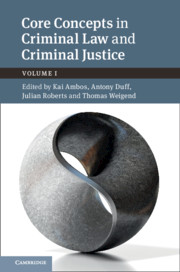Book contents
- Core Concepts in Criminal Law and Criminal Justice
- Core Concepts in Criminal Law and Criminal Justice
- Copyright page
- Contents
- Preface
- Abbreviations
- Contributors
- Part I Introduction
- Part II Criminal Law
- 2 Omissions
- 3 Preparatory Offences
- 4 Participation in Crime
- 5 Consent in the Law Relating to Sexual Offences
- 6 Terrorism Offences
- Part III Criminal Justice and Procedure
- Index
- References
4 - Participation in Crime
from Part II - Criminal Law
Published online by Cambridge University Press: 19 December 2019
- Core Concepts in Criminal Law and Criminal Justice
- Core Concepts in Criminal Law and Criminal Justice
- Copyright page
- Contents
- Preface
- Abbreviations
- Contributors
- Part I Introduction
- Part II Criminal Law
- 2 Omissions
- 3 Preparatory Offences
- 4 Participation in Crime
- 5 Consent in the Law Relating to Sexual Offences
- 6 Terrorism Offences
- Part III Criminal Justice and Procedure
- Index
- References
Summary
Questions of criminal participation arise when more than one person is in some way involved in the commission of a crime. In some cases, there may be no single individual who, in his own person, fulfils all the definitional elements of the criminal offence. Even where there is one such individual, the criminal law may want to tie other persons to the commission of the offence as well, on the basis that these other persons are complicit in and therefore share responsibility for its commission. What rules and principles do – and which ones should – govern the ascription of criminal responsibility to different agents in multi-party settings is the theme of this chapter. The answer to the should-question is approached with a view to the general aims of the criminal law regarding parties to crime. These are understood to be the following: (i) to guide judges and other decision-makers towards fair responsibility-attributions for criminal norm-violations and their outcomes; (ii) to ensure that the conviction offence fairly reflects the gravamen of the accused’s criminal conduct; and (iii) to facilitate accurate reflection of different degrees of responsibility in sentencing decisions.
- Type
- Chapter
- Information
- Core Concepts in Criminal Law and Criminal Justice , pp. 94 - 134Publisher: Cambridge University PressPrint publication year: 2020
References
- 1
- Cited by

